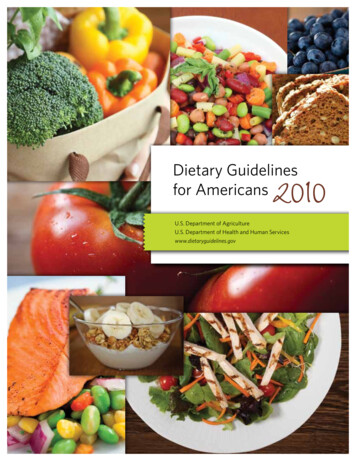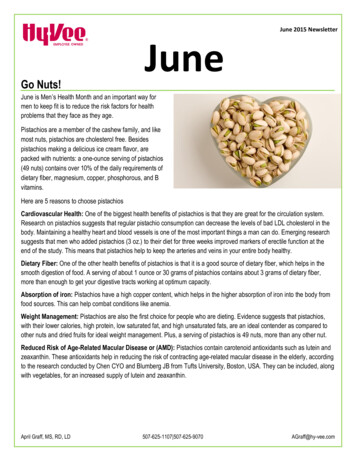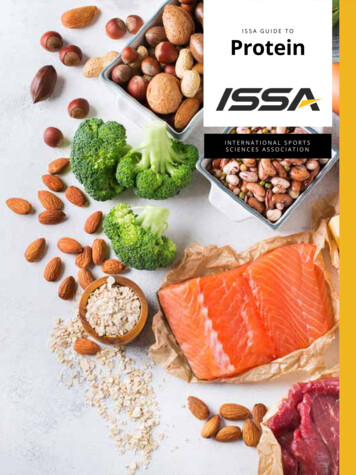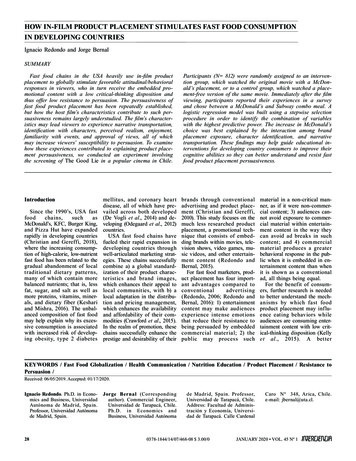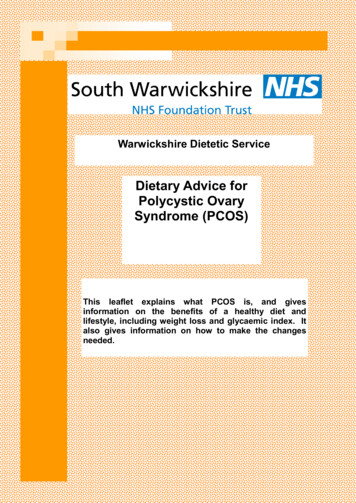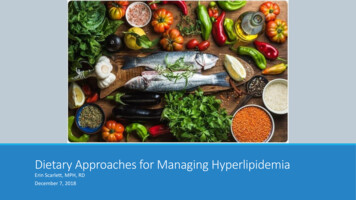
Transcription
Dietary Approaches for Managing HyperlipidemiaErin Scarlett, MPH, RDDecember 7, 2018
ObjectivesBy the end of this session, participants will be able to: Identify sources of heart-healthy fats versus saturated fats Describe how soluble fiber may be beneficial for lowering cholesterol
L Player.php?moduleSelect chlscrUS Dept of Health and Human Services, National Institutes of Health. (2005). High bloodcholesterol: What you need to know. Bethesda, MD: National Heart, Lung, and Blood Institute.
Medical Nutrition Therapy forHyperlipidemia Dietary recommendations currently from: 2013 AHA/ACC Guideline of Lifestyle Management to Reduce Cardiovascular Risk (Eckel et al.2013) National Lipid Association Recommendations for Patient-Centered Management of Dyslipidemia-- Parts 1 & 2 (Jacobson et al. 2015a and b) Dietary recommendations include: Choose unsaturated fats over saturated and trans fats Use non-tropical oils (canola, olive, avocado) Eat plenty of fruits, vegetables, and whole grains Include low-fat dairy, poultry, fish, legumes, unsalted nuts Limit red meat, sodium, sugar-sweetened beverages (SSB), and sweets
Saturated Fats (SFAs) Increase LDL-cholesterol NLA: SFA 7% of total energy intake AHA/ACC: 5 – 6% intake 2000 calorie/day diet: 5 – 7% intake of saturated fats 11 – 15 g/day
Replacing SFAsLi, Y., et al. 2015
Replacing SFAs Replacing SFA with PUFA reduces theoccurrence of CHD events by 19% Each 5% greater intake of PUFA: reduced CHD risk by 10% decreased LCL-C by 10 mg/dLMozaffarian D, et al. 2010
Replacing SFAsJacobson et al. 2015
Finding SFAs on a Nutrition Label Total fat is the combined amount ofall fats (SFA, MUFA, PUFA, and trans) Only trans and saturated fats arerequired on the label
SFAs in Food & DrinkFood/BeverageSaturated fat(g)Ground beef (3 oz)6.0Regular cheddar cheese (1 oz)6.0Chicken thigh with skin5.6Whole milk (1 cup)Food/BeverageSaturated fat(g)1 servingMeat lasagna22.6185.1Crispy Chicken Tender Salad (withGrilled Chicken)Coconut oil (1 tsp)3.7Panera Bear Claw15Cream (1 tbsp)2.9Starbucks Snowman cookie14Butter (1 tsp)2.413Mayonnaise (1 tbsp)1.6Subway Italian 6 in. (with cheeseand mayo)Egg yolk (from 1 large egg)1.6Biggby Mocha Mocha Latte 16 oz7.6Bacon (1 slice)1.19 Hershey’s Candy Cane Kisses7
Coconut Oil – A Healthy Alternative? Studies cited suggesting health benefits small in size used animal models used virgin coconut oil differs from refined coconut oil that is available to the public At 92% SFA, coconut oil contains more SFAs than butter Diets high in coconut oil can raise LDL-C Coconut oil is not recommended as a healthy oil alternative to improve lipid levelsFoodSaturated fat(g)Coconut oil (1 tsp)3.7Butter (1 -Oil-Health-Benefits.aspx
Trans Fats AHA/ACC and NLA: reduce trans fats/minimal trans fats Each 1% of energy coming from trans fats increases LDL-Cby 1.5 mg/dL compared with carbohydrates, MUFAs, or PUFAs Found in stick margarine, commercially prepared friedfoods, sweets such as pastries and cakes, and microwavepopcorn Products labeled as trans fat free may have up to 0.5 g oftrans fat per serving. FDA extended compliance date to Jan 1, 2020
Sources of Healthy FatsPOLYUNSATURATED FATS (PUFAS) Oils – soybean, corn, sunflower Tofu / Soybeans Fish – salmon, albacore tuna,trout, mackerel, herringMONOUNSATURATED FATS (MUFAS) Some nuts and seeds (walnut,sunflower, flaxseed) Avocado Oils – olive, canola, peanut, sesame Peanut butter Most nuts and fographic
Omega-3 Fatty Acids High intake of omega-3 FAs is associated with lower rates ofheart disease Omega-3 fatty acids include alpha-linolenic acid (ALA) eicosapantaenoic acid (EPA) docosahexaenoic acid (DHA) NLA recommends: ALA intake of 0.6 – 1.2% of energy NLA recommends: two 3.5 – 4 oz servings of oily fish per week equivalent to 250 – 500 mg of EPA and /essential-fatty-acids
Adding Omega-3 Fatty Acids to the Diet Eat 3.5 – 4 oz of grilled, baked, broiled, or sautéed fish at least 2x/week Fish/seafood high in omega-3 FA: salmon, pacific oysters, tuna, trout, mackerel (not king), herring,sardines, anchovies Limit fish that is high in mercury – shark, swordfish, king mackerel, tilefish, orange roughy, and big-eyetuna Use canola or soybean oil (ALA) Use ground flaxseed or flaxseed oil (ALA) Add walnuts to salads or trail mix and walnut oil in salad dressing (ALA) Choose eggs that are labeled as high in omega-3 FA (DHA) NLA recommendation: Some individuals who avoid seafood may benefit from a fish oilsupplement, if recommended by a clinician Daily supplements can provide 1 – 4 g of EPA/DHA
Dietary Cholesterol(are eggs good for you now?) AHA/ACC and NLA recommendation: 200mg/day Hyper-responders should limit to near 0 mg/day Foods high in cholesterol: Egg yolks (limit to 2 – 4/week)Shellfish – shrimp, crab, clamsOrgan meats – heart, kidney, liverFried foodsProcessed erol.html
Medical Nutrition Therapy forHyperlipidemia Choose unsaturated fats over saturated and trans fats Use non-tropical oils (canola, olive, avocado) Eat plenty of fruits, vegetables, and whole grains Include low-fat dairy, poultry, fish, legumes, unsalted nuts Limit red meat, sodium, sugar-sweetened beverages (SSB), and sweets
Fiber Insoluble Fiber (Non-viscous) Adds bulk to the stool to help you pass food easier through the digestive tract Soluble Fiber (Viscous) Attracts water in the digestive tract to form a gel-like mass Slows digestion--keeping you fuller for longer NLA recommends 5 – 10 g/day (or more) For each 1 g increase in soluble fiber 1.1 mg/dL decrease in LDL-C
Sources of FiberINSOLUBLE Vegetables – green beans, dark green leafyvegetables Fruit skins and root vegetable skins Berries Whole-wheat products Wheat bran Seeds and nutsSOLUBLE Vegetables – asparagus, Brussels sprouts,sweet potatoes, turnips, carrots Fruits – apricots, mangoes, oranges, apples,pears Legumes – black beans, navy beans, kidneybeans, peas Wheat – barley, oats, oat bran Ground flax seed
Finding Whole Grains on a NutritionLabel First ingredient: 100% whole grain or wholegrain Whole grain can be any kind of grain or amixture of grains (wheat, oats, barley,buckwheat, etc.) Multi grain contains multiple types ofgrains, but not necessarily all whole Enriched grains have been refined with nutrients added back in
Tips for Increasing Fiber To prevent uncomfortable side effects, increase fiber intakeslowly. Stay hydrated to prevent constipation and gas. Choose whole fruit instead of juice. Eat the skin on fruits and vegetables if possible. Choose whole grain cereals and bread. Increase intake of beans by adding to soups or salads. If it is difficult to get the recommended daily amount from food alone, fiber supplementssuch as Benefiber, Metamucil, or fiber gummies may be considered. “Start low and go ortance-of-Dietary-Fiber.aspx
Plant Sterols and Stanols NLA recommendation: Consumption of 2g/day of plant sterols and stanols candecrease LDL-C by 4 – 10% Occur naturally in foods, but in small amounts. vegetable oils, nuts, seeds, whole grains The average American consumes 200 – 400 mg/day X2 for vegans Fortified sources – margarine spreads, orange juice, cereal, breakfast bars,dietary supplements 1 tbsp Benecol buttery spread 70 calories, 0.5 g of plant stanols 4 tbsp/day of Benecol 280 calories, 2 g of plant stanols
Medical Nutrition Therapy forHyperlipidemia Choose unsaturated fats over saturated and trans fats Use non-tropical oils (canola, olive, avocado) Eat plenty of fruits, vegetables, and whole grains Include low-fat dairy, poultry, fish, legumes, unsalted nuts Limit red meat, sodium, sugar-sweetened beverages (SSB), and sweets
Role of the Registered Dietitian “Nutritional counseling and follow-up/monitoring by a registered dietitian nutritionist arerecommended whenever possible to individualize patients’ cardioprotective dietary patternsand to promote long-term dietary adherence.” – NLA, 2015
Heart-Healthy Dietary Patterns Dietary Approaches to Stop Hypertension (DASH) (AHA/ACC and NLA) USDA – Healthy U.S.-style (AHA/ACC and NLA) American Heart Association (AHA/ACC and NLA) Mediterranean style (NLA) Vegetarian/vegan (NLA) The specific diet recommendation should be individualized and depend on the patient’s lifestyle,cultural beliefs, other health factors, and source/healthy-eating-plate/
DASH DietFood GroupRecommended servingsGrains and grain products4 – 8 / dayVegetables3 – 5 / dayFruits3 – 5 / dayLow-fat or fat-free dairy2 – 3 / dayLean meat, poultry, fish3 – 6 oz / dayNuts, seeds, and drybeans3 – 5 / weekFats and oils1 – 3 / daySweets3 – 5 or less / weekAdditional Recommendations 2300 mg of sodium/day Adequate calcium intake Adequate magnesium intake from foodsources High potassium 4700 mg/day 30 – 45 minutes of physical activity onmost days Moderate alcohol
Mediterranean Diet No one definition of a Mediterranean diet Most interpretations have similar characteristics: Daily use of fruits, vegetables, bread, cereals, potatoes, beans, nuts, and seedsOlive oilLow to moderate amounts of dairy, fish, and poultryVery low amounts of red meatEggs consumed 0-4x/weekWine is consumed in low to moderate amounts Moderate in fat (32-35% of total calories) Higher in SFA than is recommended for many (9-10% of total calories) Found to improve cholesterol, triglycerides, blood pressure, and fastingblood glucose levels
Vegetarian / Vegan DietsSemi-vegetarian Pescatarian Lacto-ovo vegetarianLacto-vegetarian Ovo-vegetarian Vegan Adopting a vegetarian or vegan diet can help improve hyperlipidemia Generally low in saturated fat and high in fiber from whole grains, fruits, and vegetables Cheese? Semi-vegetarianism, or only occasionally consuming meat, is associated with improvedcholesterol levels and can be a good alternative for individuals who do not want to eliminatemeat.
Lifestyle Recommendations Work towards a healthy weight (5 – 10% weight loss can be helpful) Aim for 30 minutes of physical activity on most days 200 – 300 minutes of moderate-intensity physical activity per week can help decrease weight and lowerLDL-C Limit alcohol consumption to 1 drink/day for women and 2 drinks/day for men If you do not drink, it is not recommended to add red wine or any other form of alcohol Do not smoke Get the recommended amount of sleep each night (7 – 9 hours) Manage stress
Clinical algorithmfor screening andmanagement ofelevated TGJacobson et al. 2015
Patient Resources American Heart Association (AHA) www.heart.org Articles, infographics, healthy recipes Academy of Nutrition and Dietetics (AND) www.eatright.org Articles, tips, healthy recipes MHealthy being/mhealthy Recipes, University-wide events and resources Mediterranean Diet: an-diet Tips sheets, grocery list DASH Diet: -plan General description of diet, calorie levels/foodgroups, links to recipes Vegetarian/Vegan: https://vegetariannutrition.net/ Recipes and informational articles
Special Thanks tofor her contributions to this presentation
ReferencesAmerican Dietetic Association. Disorder of Lipid Metabolism. Nutrition Care Manual. Accessed Oct 17, 2018.The American Heart Association's Diet and Lifestyle Recommendations. (n.d.). Retrieved from le-recommendationsCenter for Food Safety and Applied Nutrition. (n.d.). Labeling & Nutrition - Changes to the Nutrition Facts Label. Retrieved tion/ucm385663.htmEssential Fatty Acids. (2018, September 10). Retrieved from sential-fatty-acidsHu FB, Stampfer MJ, Rimm EB, et al. A prospective study of egg consumption and risk of cardiovascular disease in men and women.JAMA. 1999; 281:1387-1394. AbstractJacobson, T. A., Ito, M. K., Maki, K. C., Orringer, C. E., Bays, H. E., Jones, P. H., . . . Brown, W. V. (2014). National Lipid Associationrecommendations for patient-centered management of dyslipidemia: Part 1. Journal of Clinical Lipidology, 8(5), 473-488.doi:10.1016/j.jacl.2014.07.007Jacobson TA, Maki KC Brown WV. National Lipid Association recommendations for patient-centered management of dyslipidemia:Part 2. Journal of Clinical Lipidology. 9(6), S1-S122.e1. doi: 10.106/j.jacl.2015.09.002Li, Y., Hruby, A., Bernstein, A. M., Ley, S. H., Wang, D. D., Chiuve, S. E., . . . Hu, F. B. (2015). Saturated Fats Compared With UnsaturatedFats and Sources of Carbohydrates in Relation to Risk of Coronary Heart Disease. Journal of the American College of Cardiology,66(14), 1538-1548. doi:10.1016/j.jacc.2015.07.055McRae, M. P. (2017). Dietary Fiber Is Beneficial for the Prevention of Cardiovascular Disease: An Umbrella Review of Meta-analyses.Journal of Chiropractic Medicine, 16(4), 289-299. doi:10.1016/j.jcm.2017.05.005Mediterranean Diet. (2018). Retrieved from ing/eat-smart/nutritionbasics/mediterranean-diet
ReferencesMozaffarian D, Micha R, Wallace S. Effects on coronary heart disease of increasing polyunsaturated fat in place of saturated fat: asystematic review and meta-analysis of randomized controlled trials. PLoS Med. 2010;7:e1000252.Pernille LB Hollænder, Alastair B Ross, Mette Kristensen; Whole-grain and blood lipid changes in apparently healthy adults: a systematicreview and meta-analysis of randomized controlled studies–, The American Journal of Clinical Nutrition, Volume 102, Issue 3, 1 September2015, Pages 556–572, https://doi.org/10.3945/ajcn.115.109165Sialvera, TE, Papadopoulou A, et al. Structured advice provided by a dietitian increases adherence of consumers to diet and lifestylechanges and lowers blood low‐density lipoprotein (LDL)‐cholesterol: the Increasing Adherence of Consumers Diet & Lifestyle Changes toLower (LDL) Cholesterol (ACT) randomised controlled trial. J Hum Nutr Diet. 2018 Apr, 31(2):197:208. doi: 10.1111/jhn.12508. Epub 2017Sep 11.Tangney, C., Rosenson, R. (2018). Lipid Lowering with Diet or Dietary Supplements. UpToDateTheuwissen E, Mensink RP. Water-soluble dietary fibers and cardiovascular disease. Physiol Behav. 2008;94:285-292.US Dept of Health and Human Services, National Institutes of Health. (2005). High blood cholesterol: What you need to know. Bethesda,MD: National Heart, Lung, and Blood Institute.U.S. Department of Health and Human Services and U.S. Department of Agriculture. 2015 – 2020 Dietary Guidelines for Americans. 8thEdition. December 2015. Available at es/.Yoko Yokoyama, Susan M Levin, Neal D Barnard; Association between plant-based diets and plasma lipids: a systematic review and metaanalysis, Nutrition Reviews, Volume 75, Issue 9, 1 September 2017, Pages 683–698, https://doi.org/10.1093/nutrit/nux030
Use canola or soybean oil (ALA) Use ground flaxseed or flaxseed oil (ALA) Add walnuts to salads or trail mix and walnut oil in salad dressing (ALA) Choose eggs that are labeled as high in omega-3 FA (DHA) NLA recommendation: Some individuals who avoid seafood may benefit from a fish





